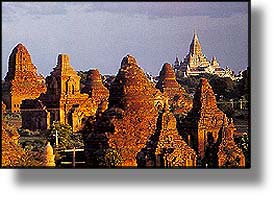| Adventure in Burma
(Myanmar) Burma (Myanmar) Homepage | Asia Homepage | The World
The capital city of Burma is the most accessible place to start exploring the country. Yangon is a charming city, with wide streets and a lingering air of tropical and colonial decay. Although there are several points of interest in the city, the towering Shwedagon Pagoda literally stands above them all. Situated atop a hill that overlooks all of Yangon, this glittering temple is undoubtedly one of the most awe-inspiring structures in all of Asia. Its 100-meter spire, a construction that would make Donald Trump envious, is sheathed in eight thousand gold plates and crowned with more than five thousand diamonds and other precious stones. As one might expect, the Shwedagon Pagoda is the holiest of Buddhist sites in Burma.
Tragedies have destroyed many of Mandalay's finest attractions, including most notably the massive wooden royal palace (which burned in the Second World War). Although Mandalay still contains many interesting pagodas and temples, it is now better known as a departure point for the surrounding deserted cities. In Amarapura, after a walk across the precarious U Beins Bridge visitors can enter the Kyauktawggyi Pagoda. Sagaing contains splendid examples of ancient Buddhist temples and a pagoda modeled on the breast of a queen. The ruins at Ava include the Maha Aungmye Bonzan monastery. Mingun, a few miles upriver from Mandalay, contains the ruins of what was to be the world's largest pagoda. It is also home to the largest uncracked bell in the world.
To truly experience the splendor of ancient Burma, a trip to Bagan is a must. For over two hundred years, from 1057- 1287, the Burmese kings held court here. Generous patrons of the arts, they adorned their capital with literally hundreds of intricate Buddhist temples and monuments. Although the arrival of Kublai Khan brought the city to its knees, the construction to a halt, and the population to near extinction, Bagan's myriad temples remain. Inle Lake, curdled with lush surface vegetation, is the home of Burma's extraordinary leg-rowers. In order to navigate their way through the dense water-plants, the locals stand in the aft of their boats--not unlike Venetian gondoliers. However, rather than using a pole to propel the boat forward, the leg-rowers steady themselves on one foot while using their second leg to row. In addition to its unique mode of transport, Inle Lake is also known for its charming floating villages, Ywama and Phaungdaw, and its floating market.
Burma (Myanmar) Homepage | Asia Homepage | The World |
|
 Only recently have tourists been able to
obtain 30-day visas for travel to Burma. The
longstanding restriction on such travel has left Burma
virtually untouched by modern western culture, and the
country's impressive historical heritage remains largely
intact. While the government still officially limits
travel to certain areas of the country, it is in practice
not very difficult to venture outside of the designated
tourist sites. That said, all of the following places
have the official thumbs up for foreign visitation.
Only recently have tourists been able to
obtain 30-day visas for travel to Burma. The
longstanding restriction on such travel has left Burma
virtually untouched by modern western culture, and the
country's impressive historical heritage remains largely
intact. While the government still officially limits
travel to certain areas of the country, it is in practice
not very difficult to venture outside of the designated
tourist sites. That said, all of the following places
have the official thumbs up for foreign visitation.